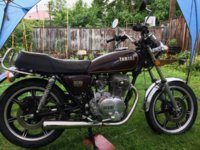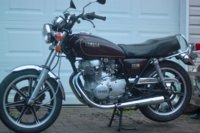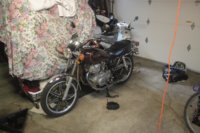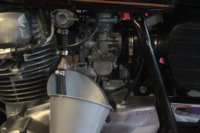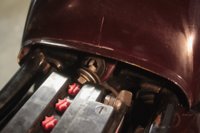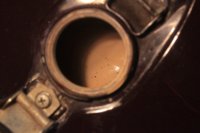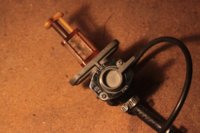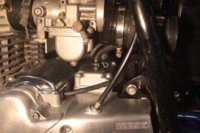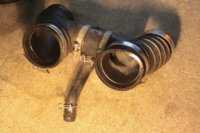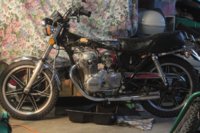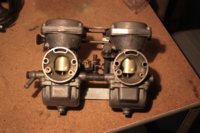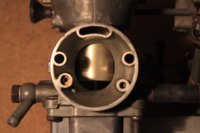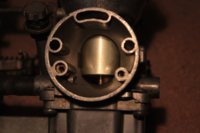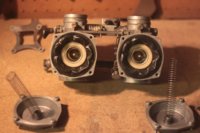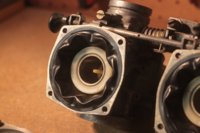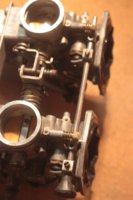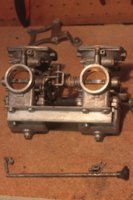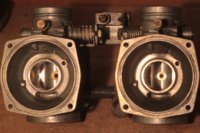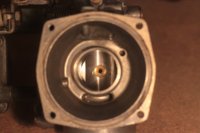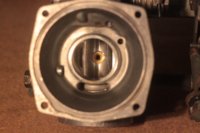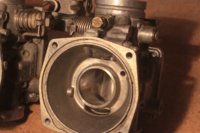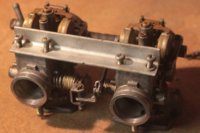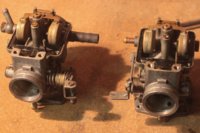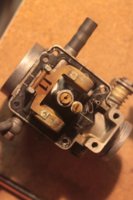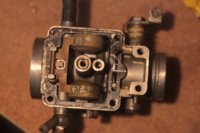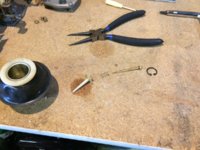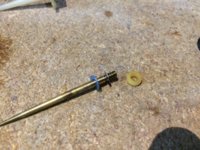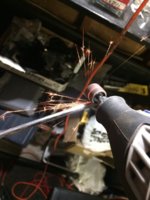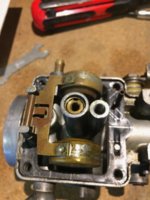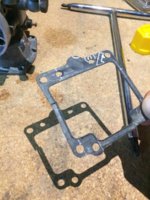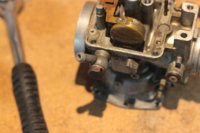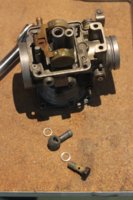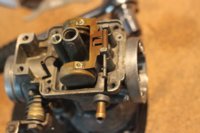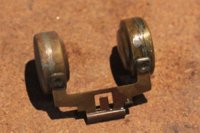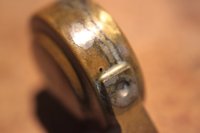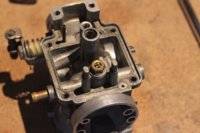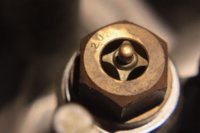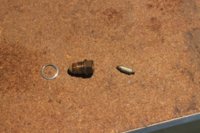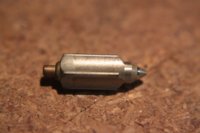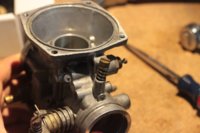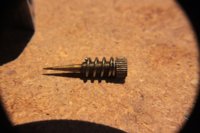seanneyb
XS400 Member
Hi everyone,
My XS400 is from 1979; I bought it a few months ago as my first motorcycle (I've been riding a scooter for about 8 years and decided it was finally time to upgrade). Appearance-wise, it looks to be in pretty nice shape, and has ~5100km on the odometer. Brought my motorcycle buddy to test drive it, started up fine, ran fine but had a bit of a tendency to backfire ~6000 RPM. Figured it just needed a tune-up and fluids so I took it to the shop I've had the scooter serviced.
Evidently a lot of the electrical needed to be replaced, and wasn't charging properly, so the shop ended up rebuilding the stator and field coil assembly, installed a regulator/rectifier, and replaced the fusebox with inline blade fuses. They also installed new fuel lines and added a fuel filter (as well as new tires, and a few other maintenance things)
I got it back and have ridden it a few times. It was still backfiring around 6k, and hesitating quite a bit, especially if I'm on the throttle. And it would occasionally die instead of idling. I got in touch with the shop, and their response was basically "old bikes are finicky; the next step is check compression, timing, and valves, and estimated 4-5 hours of labour. I've already paid them a lot of money to get it to where it is now, and figured it's time to learn how to fix my bike myself (I've never worked on motorcycles before, but I follow instructions well and have worked on my own cars since I've been driving)
Around this time I found this forum and started searching. There's a lot of information here! I bought a compression tester, and it seems to check out - 155 on the left, 162 on the right.
I added a quarter can of Sea-Foam to the gas tank, hoping for a quick fix, and the next day I rode it and it was backfiring and hesitating even more. I read how the timing might be off, and borrowed my housemate's timing light. I have no idea what's going on but the timing seems WAY off (lights up well before RF, doesn't light up at all for LF; here's the most confusing thing: it lights up on both sides for RF??). I put things back to where they were, because I couldn't get the timing adjusted close enough on RF, and who knows what's going on with the other side). I did notice that the left spark plug was kinda sooty, so I cleaned it up with some sand paper.
Then I started her up...and took her for a ride...and she was great. Best she's been yet, at least. The backfiring was *almost* gone, and she didn't stall once.
Next day, go to start her. Has trouble catching over, and when it is, really idling low and gurgly. And dies. So I start her again, and close, but nothing. Try one more time and I notice gas POURING OUT OF THE LEFT AIR BOX. Thought I may have flooded the carb trying to start it, and got busy the next day. Tried it two days later and same thing, won't start, gas is now pouring out of the exhaust (I was pointed slightly downhill this time) and I also noticed the left exhaust pipe is cold. Pulled that spark plug off and saw that it was soaked in gasoline. That's where we stand now.
From what I've read and experienced, it seems like:
a. something is seriously wrong with the timing and/or
b. something is wrong with the carbs - specifically the left, and possibly related to the float valve. or maybe
c. something is wrong with the petcock, although the shop checked it and said it was fine.
Does this seem about right? What would everyone recommend checking and fixing first? Anyone have any idea why the timing seems so strange?
Here's a picture, because I hear you like pictures (I've got more but I'll have to resize them in order to upload):

And thanks for any advice you might have. I've only had a couple good rides on my bike but it's been so fun, and I'm hoping I can learn how to sort out these issues and learn about motorcycle repair in general!
My XS400 is from 1979; I bought it a few months ago as my first motorcycle (I've been riding a scooter for about 8 years and decided it was finally time to upgrade). Appearance-wise, it looks to be in pretty nice shape, and has ~5100km on the odometer. Brought my motorcycle buddy to test drive it, started up fine, ran fine but had a bit of a tendency to backfire ~6000 RPM. Figured it just needed a tune-up and fluids so I took it to the shop I've had the scooter serviced.
Evidently a lot of the electrical needed to be replaced, and wasn't charging properly, so the shop ended up rebuilding the stator and field coil assembly, installed a regulator/rectifier, and replaced the fusebox with inline blade fuses. They also installed new fuel lines and added a fuel filter (as well as new tires, and a few other maintenance things)
I got it back and have ridden it a few times. It was still backfiring around 6k, and hesitating quite a bit, especially if I'm on the throttle. And it would occasionally die instead of idling. I got in touch with the shop, and their response was basically "old bikes are finicky; the next step is check compression, timing, and valves, and estimated 4-5 hours of labour. I've already paid them a lot of money to get it to where it is now, and figured it's time to learn how to fix my bike myself (I've never worked on motorcycles before, but I follow instructions well and have worked on my own cars since I've been driving)
Around this time I found this forum and started searching. There's a lot of information here! I bought a compression tester, and it seems to check out - 155 on the left, 162 on the right.
I added a quarter can of Sea-Foam to the gas tank, hoping for a quick fix, and the next day I rode it and it was backfiring and hesitating even more. I read how the timing might be off, and borrowed my housemate's timing light. I have no idea what's going on but the timing seems WAY off (lights up well before RF, doesn't light up at all for LF; here's the most confusing thing: it lights up on both sides for RF??). I put things back to where they were, because I couldn't get the timing adjusted close enough on RF, and who knows what's going on with the other side). I did notice that the left spark plug was kinda sooty, so I cleaned it up with some sand paper.
Then I started her up...and took her for a ride...and she was great. Best she's been yet, at least. The backfiring was *almost* gone, and she didn't stall once.
Next day, go to start her. Has trouble catching over, and when it is, really idling low and gurgly. And dies. So I start her again, and close, but nothing. Try one more time and I notice gas POURING OUT OF THE LEFT AIR BOX. Thought I may have flooded the carb trying to start it, and got busy the next day. Tried it two days later and same thing, won't start, gas is now pouring out of the exhaust (I was pointed slightly downhill this time) and I also noticed the left exhaust pipe is cold. Pulled that spark plug off and saw that it was soaked in gasoline. That's where we stand now.
From what I've read and experienced, it seems like:
a. something is seriously wrong with the timing and/or
b. something is wrong with the carbs - specifically the left, and possibly related to the float valve. or maybe
c. something is wrong with the petcock, although the shop checked it and said it was fine.
Does this seem about right? What would everyone recommend checking and fixing first? Anyone have any idea why the timing seems so strange?
Here's a picture, because I hear you like pictures (I've got more but I'll have to resize them in order to upload):
And thanks for any advice you might have. I've only had a couple good rides on my bike but it's been so fun, and I'm hoping I can learn how to sort out these issues and learn about motorcycle repair in general!

 Also, when I connected the test light to the points...metal spring thing...there were little electric shocks that would occur. Is that cool or naw?
Also, when I connected the test light to the points...metal spring thing...there were little electric shocks that would occur. Is that cool or naw?